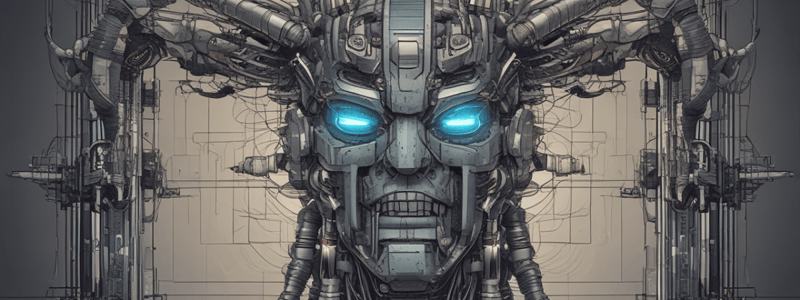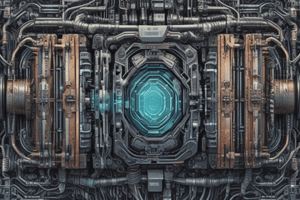Podcast
Questions and Answers
What is the primary advantage of using ferrite cores in transformer design?
What is the primary advantage of using ferrite cores in transformer design?
- Wide frequency range compatibility
- High power handling capabilities
- High magnetic permeability and low eddy current losses (correct)
- Low cost and compact size
What is the main benefit of using a toroidal core shape in transformer design?
What is the main benefit of using a toroidal core shape in transformer design?
- High power handling capabilities
- Cost-effectiveness
- Excellent magnetic coupling (correct)
- Compact size
What determines the voltage transformation in a transformer?
What determines the voltage transformation in a transformer?
- Winding configuration
- Core material
- Turns ratio between primary and secondary windings (correct)
- Core shape
Why are laminated steel cores preferred for high-frequency applications?
Why are laminated steel cores preferred for high-frequency applications?
What is the advantage of using powdered iron cores?
What is the advantage of using powdered iron cores?
What is a crucial factor in selecting the right wire for transformer windings?
What is a crucial factor in selecting the right wire for transformer windings?
What is the primary purpose of insulation in a transformer?
What is the primary purpose of insulation in a transformer?
What is a common material used for transformer cores?
What is a common material used for transformer cores?
What is a key consideration in the design of a transformer?
What is a key consideration in the design of a transformer?
What is the purpose of transformer oil?
What is the purpose of transformer oil?
What is an alternative to mineral oil with higher thermal stability and lower flammability?
What is an alternative to mineral oil with higher thermal stability and lower flammability?
What is commonly used for transformer tanks to reduce weight?
What is commonly used for transformer tanks to reduce weight?
What is used to provide insulation between the transformer and external electrical systems?
What is used to provide insulation between the transformer and external electrical systems?
What is a key component of the transformer architecture in natural language processing?
What is a key component of the transformer architecture in natural language processing?
What is added to the input embeddings in transformers to give the model information about the positions of tokens in the sequence?
What is added to the input embeddings in transformers to give the model information about the positions of tokens in the sequence?
What is the primary purpose of the core in a transformer?
What is the primary purpose of the core in a transformer?
What is the purpose of positional encodings in transformers?
What is the purpose of positional encodings in transformers?
What is the significance of the cross-sectional area of the core in a transformer?
What is the significance of the cross-sectional area of the core in a transformer?
What is the advantage of using stepped core over rectangular core?
What is the advantage of using stepped core over rectangular core?
What is the primary purpose of the yoke in a transformer?
What is the primary purpose of the yoke in a transformer?
What is the main factor influencing hysteresis loss?
What is the main factor influencing hysteresis loss?
What is the effect of increasing the sequence length in transformers?
What is the effect of increasing the sequence length in transformers?
What is the primary reason for estimating core loss?
What is the primary reason for estimating core loss?
What is the purpose of the attention mechanism in transformers?
What is the purpose of the attention mechanism in transformers?
What is the first step in estimating project costs based on design data?
What is the first step in estimating project costs based on design data?
What is the main objective of cost-effective manufacturing techniques in transformer design?
What is the main objective of cost-effective manufacturing techniques in transformer design?
What is the primary purpose of regulatory compliance in transformer design?
What is the primary purpose of regulatory compliance in transformer design?
What is the main benefit of tailoring the core design to the specific requirements of the application?
What is the main benefit of tailoring the core design to the specific requirements of the application?
What is the main consideration in performing life-cycle cost analysis of a transformer?
What is the main consideration in performing life-cycle cost analysis of a transformer?
What is the main trade-off in optimizing transformer design for minimum losses, minimum weight, and minimum volume?
What is the main trade-off in optimizing transformer design for minimum losses, minimum weight, and minimum volume?
What is the unit of measurement for specific magnetic loading?
What is the unit of measurement for specific magnetic loading?
What is the formula to calculate specific magnetic loading?
What is the formula to calculate specific magnetic loading?
What is the purpose of balancing specific magnetic and electric loading in transformer design?
What is the purpose of balancing specific magnetic and electric loading in transformer design?
What is the unit of measurement for specific electric loading?
What is the unit of measurement for specific electric loading?
What is the expression for the induced emf in the primary winding of a transformer?
What is the expression for the induced emf in the primary winding of a transformer?
What is the purpose of breaking down a project into smaller tasks or work packages?
What is the purpose of breaking down a project into smaller tasks or work packages?
Which cost estimation technique involves comparing with similar past projects?
Which cost estimation technique involves comparing with similar past projects?
What is a key consideration in designing the optimum core for a transformer?
What is a key consideration in designing the optimum core for a transformer?
What is the purpose of peer review in cost estimation?
What is the purpose of peer review in cost estimation?
What is the purpose of continuously monitoring the project's progress and comparing it against the estimated costs?
What is the purpose of continuously monitoring the project's progress and comparing it against the estimated costs?
Flashcards are hidden until you start studying
Study Notes
Transformer Core Design
- Ferrite, laminated steel, and powdered iron are common core materials used in transformer design.
- Core shape depends on application, power handling, and available space; common shapes include toroidal, E-core, I-core, and U-core.
Winding Configuration
- The winding configuration is critical to transformer performance.
- The turns ratio between primary and secondary windings determines voltage transformation.
Wire Selection
- Wire choice depends on factors such as current-carrying capacity, resistance, and insulation properties.
- Copper and aluminum are commonly used wire materials.
Insulation
- Insulation is crucial to prevent short circuits between windings and ensure transformer reliability and safety.
- Common insulating materials include paper, Mylar, Nomex, and various tapes.
Cooling
- Transformers generate heat during operation, requiring adequate cooling measures such as ventilation or cooling fins.
Frequency and Application Considerations
- Transformer design must consider frequency of operation and application requirements.
- These factors influence core material selection, core shape, and winding configurations.
Size and Weight Constraints
- Physical size and weight constraints are crucial considerations in transformer design.
- Design must balance performance requirements with practical considerations.
Efficiency and Losses
- Minimizing core losses (hysteresis and eddy current losses) and copper losses is essential for high efficiency.
Regulatory Compliance
- Transformer designs must comply with safety and performance standards relevant to the application and region.
Testing and Quality Control
- Transformers undergo rigorous testing to ensure they meet specified performance criteria.
- Quality control measures during manufacturing are crucial for producing reliable transformers.
Material Selection
- Selecting the right materials for transformers is crucial for optimal performance, reliability, and efficiency.
- Materials must meet specific electrical, thermal, and mechanical requirements.
Transformer Oil
- Mineral oil, silicone oil, and vegetable oil are used for insulation and cooling in transformers.
Tank and Enclosure Materials
- Steel and aluminum are commonly used for transformer tanks, providing durability and protection for internal components.
Gaskets and Seals
- Rubber and cork are used for gaskets and seals in transformers to prevent moisture ingress.
Cooling Systems
- Radiators and fans are used to dissipate heat in transformers, with materials such as aluminum or stainless steel used for corrosion resistance.
Bushings
- Porcelain and polymer materials are used for bushings, providing insulation between the transformer and external electrical systems.
Fasteners and Structural Components
- Stainless steel is used for certain structural components and fasteners, providing corrosion resistance.
Type of Construction
Transformers in Deep Learning
- The transformer architecture is a type of neural network introduced in 2017.
- Key components include self-attention mechanisms, encoder-decoder structures, multi-head attention, and feed-forward neural networks.
Specific Magnetic and Electric Loadings
- Magnetic loading refers to the amount of magnetic flux passing through a given area within a magnetic circuit.
- Electric loading refers to the amount of current flowing through a conductor or winding.
Output Equation of Transformer
- The output equation of a transformer is E = 4.44 f N Ø max / √2, where E is the induced emf, f is the frequency, N is the number of turns, Ø max is the maximum flux density, and A is the cross-sectional area of the core.
Core and Yoke Cross Sections
- The core and yoke cross sections are critical components of a transformer, affecting magnetic flux density and saturation.
- The efficient design of the core and yoke cross sections is essential for maximizing transformer performance and minimizing energy losses.
Window Dimensions of Transformer Design
- Sequence length and attention mechanisms are crucial considerations in transformer design.
- Attention windows can be limited to reduce computational complexity and memory requirements.
Advantages of Stepped Core over Rectangular Core
- Stepped cores offer better mechanical strength and utilize space more efficiently than rectangular cores.
Core Loss Estimation from Design Data
- Core loss can be categorized into hysteresis loss and eddy current loss.
- Core loss estimation is crucial for optimal transformer design and efficiency.### Core Loss in Transformers
- Two main types of core losses: hysteresis loss and eddy current loss
- Hysteresis loss: energy loss due to magnetic field reversal, influenced by material properties, frequency, and amplitude of magnetic flux
- Eddy current loss: energy loss due to circulating currents in the core, influenced by core material thickness and resistivity, and frequency of alternating magnetic field
- Total core loss is the sum of hysteresis loss and eddy current loss
Estimation from Design
- Involves analyzing design specifications, understanding project scope, and predicting resources required
- Steps involved:
- Review design documents
- Breakdown of work into manageable tasks
- Quantify materials and resources required
- Use cost estimation techniques (analogous, parametric, bottom-up)
- Risk assessment and contingency funds
- Consider inflation and market trends
- Integrate with project schedule
- Document assumptions and limitations
- Peer review and approval
Optimum Core Design for Minimum Cost
- Material selection: balancing magnetic properties and cost
- Core shape and size: optimizing for minimum material usage and performance
- Core losses: minimizing hysteresis and eddy current losses
- Winding configuration: efficient magnetic flux linkage and reduced leakage inductance
- Temperature considerations: balancing cooling costs with core efficiency
- Manufacturing techniques: cost-effective and material-efficient
- Regulatory compliance: meeting industry standards and regulations
- Customization for application: tailoring core design to specific requirements
- Life-cycle cost analysis: considering initial purchase, operating, and maintenance costs
- Reliability and durability: balancing cost with long-term performance and maintenance
Minimum Losses, Weight, and Volume
- Minimum losses: optimizing neural network model parameters using techniques like gradient descent
- Minimum weight: reducing model parameters using regularization and compression techniques
- Minimum volume: reducing memory and storage requirements using model compression and knowledge distillation
- Optimizing for these aspects often involves trade-offs between performance, size, and complexity
Studying That Suits You
Use AI to generate personalized quizzes and flashcards to suit your learning preferences.





